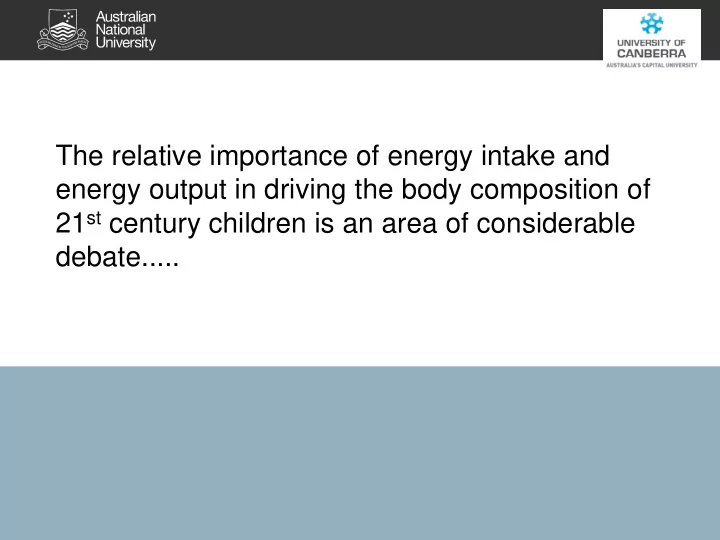

The relative importance of energy intake and energy output in driving the body composition of 21 st century children is an area of considerable debate.....
Our contribution to the debate was to evaluate the effects of physical activity and dietary intake on the percent body fat of 730 healthy, community-based Australian children and adolescents In children: Determinants of percent body fat: evidence from the LOOK study (PLoS One. 2012; 7(11) Telford RD, Cunningham RB,Telford RM, Riley M and Abhayaratna WP) In adolescents : Variation in percent body fat: the LOOK longitudinal study (Telford RD, Telford RM, Martin MK, Welvaert M (submitted for publication 2019)
In the Australian LOOK longitudinal Study, we measured... 734 children, measured at 8, 10, 12, and 16y, • Height, weight • Percent body fat (DEXA) • physical activity/sedentary time (pedometers and accelerometers) • energy, fat, carbohydrate and sugar intake ( Multi-Pass weekend/weekday 24h recall, with Goldberg cutoff to offset under-reporting) as per National Children’s Nutrition and Physical Activity Survey ) • the only childhood/adolescent study to have used each of these objective methods together in the one longitudinal study
Our main findings were consistent across the 8, 10, 12, and 16 year-olds 4
But before we present the findings....here’s one instance showing why methodology is so critical, and why many childhood longitudinal studies are likely to have flawed outcomes..... 5
BMI might be easy to measure....but it’s fraught with error in longitudinal studies of children and adolescents Telford RD, Cunningham RB, Abhayaratna WP. Temporal divergence of percent body fat and body mass index in pre-teenage children: the LOOK longitudinal study. Pediatr Obes. 2014 Dec;9(6):448-54
...and even more evident in boys from age 12 to 16 A 15% INCREASE IN BMI coincided with 25% DECREASE IN %BF Telford RD, Telford RM, Welvaert M. BMI is a misleading proxy for adiposity in longitudinal studies with adolescent males: The Australian LOOK study. J Sci Med Sport. 2019 Mar;22(3):307-310
• So what did our LOOK study data show? 8
Firstly, overweight and obese children did NOT consume more kilojoules.....! And the same held true in the adolescents .... 9
...and the overweight and obese children consumed NO MORE SUGAR or carbohydrates than their leaner counterparts...
The overweight and obese children DID NOT consume more dietary fat...
Indeed, teenage boys with higher %body fat consumed LESS carbohydrates
How could this be? 13
Well, it was simply that the children with higher % Body Fat, including the overweight and obese children, were proportionately LESS ACTIVE
.... the overweight and obese children being less moderately and vigorously active
As well as (children with higher %body fat) proportionately more sedentary .... 16
In summary these data • do not imply or suggest in any way that nutritional intake is unimportant for our children’s health; we all know it is extremely important • Nor do they suggest that dietary quantity and quality are unrelated to body composition • But what they do show is that typical Australian children and adolescents with higher %BF cannot be differentiated according to the dietary variables we measured...but that they can be differentiated according to their physical activity and sedentary time • Suggesting that physically active youngsters are better able to balance energy in and out than their inactive peers • And that community campaigns to reduce the prevalence of obesity in Australian youth might be better served by focussing even more strongly on reducing the high prevalence of insufficient physical activity
Hope this stimulates plenty of discussion! 18
19
Our data in a day to day context...take twins A and B... Twin A, as usual, is outside kicking a football for an hour or so and ducks inside and grabs a couple of biscuits... Twin B, as usual, is inside playing a computer game, and only has one biscuit... But Twin A is in negative energy balance, and Twin B is in positive energy balance ...and Twin A, who might eat more than than Twin B, is leaner 20
For example.... An average child of age 12 who had 30 minutes more MVPA/day had a % Body fat of 23% compared with 25%, about 1.2 kg of fat .
Recommend
More recommend